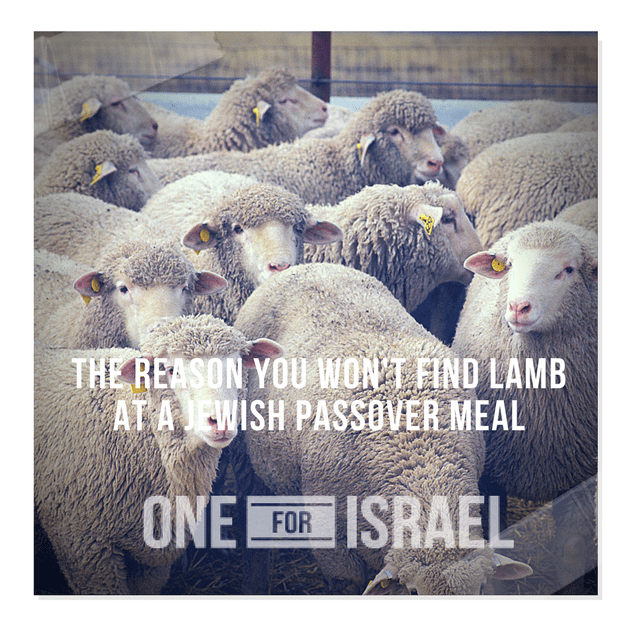
Re-published From One For Israel.org
One lamb sacrificed for everyone
The plural for lamb does not appear in the Bible. There is only ever lamb singular. Sometimes the plural for sheep is used, and translated as lambs, but the Hebrew for lambs is not in there. There is only one Lamb! In the Exodus story, it makes sense grammatically, even though they are using lamb in the singular, as you can see:
“Tell all the congregation of Israel that on the tenth day of this month, each man is to take a lamb for his family one lamb for the household. But if the household is too small for a lamb, then he and his nearest neighbor are to take one according to the number of the people. According to each person eating, you are to make your count for the lamb. Your lamb is to be without blemish, a year old male. You may take it from the sheep or from the goats. You must watch over it until the fourteenth day of the same month. Then the whole assembly of the congregation of Israel is to slaughter it at twilight. They are to take the blood and put it on the two doorposts and on the crossbeam of the houses where they will eat it. They are to eat the meat that night, roasted over a fire. With matzot and bitter herbs they are to eat it.” (Ex 12:3-8)
But even so – the whole assembly slaughters IT?
Later on in Leviticus 23 we read that the priests slaughter one lamb for everyone, and also in Ezra 6 we see the same thing:
The exiles celebrated the Passover on the fourteenth day of the first month, for every one of the kohanim and the Levites had purified themselves and all of them were ceremonially pure. They slaughtered the Passover lamb [the “Pesach” or “Passover”] for all the exiles, and for their fellow kohanim and for themselves. So those of Bnei-Yisrael who had returned from the exile ate it, together with all who had separated themselves from the impurity of the nations of the land to seek Adonai the God of Israel. (Ez 6:19-21)
2 Chronicles 35:11-13 repeats the same story – one lamb [“Pesach”] sacrificed for the many. This points to God’s intention, that the Feast of Passover is about one lamb: the Lamb of God, who takes away the sin of the world.
From one lamb per family to no lambs at all
When looking at Jewish history, however, the Mishna describes in detail how the festival was celebrated around the time of Yeshua, and it seems that each family had their own Passover lamb.
While the temple was still standing, it was usual for the people of Israel to descend upon the city of Jerusalem, and bring a lamb or goat for each family to be slaughtered. The priests would ritually sacrifice the animals and take a bowl of the blood to pour on the altar, before giving the meat back to the family to be cooked on pomegranate branch skewers and enjoyed in the evening. Due to the large numbers arriving, there sacrifices were done in three “sittings” so to speak.[1] So a lamb per family, as you might imagine from the instructions in Exodus 12.
But after the fall of the temple in 70 AD, there was a rabbinic dispute about how to proceed on this matter, along with many others. Opinion was divided about whether to have each family sacrifice and eat their lamb or goat at home (Rabbi Gamaliel’s proposal), or to avoid the lamb issue altogether, since only priests could carry out such sacrifices in the temple according to Jewish law – for that to happen, they would have to wait for the Messiah to come, and for the rebuilding of a new temple.
It wasn’t long before those opposing Gamaliel’s home sacrifice suggestion gained control and threatened anyone defying the ban with excommunication. A couple of generations after the death and resurrection of Yeshua, the practice of sacrificing animals for Passover stopped altogether.
From that time forth, lamb was off the table and off the menu.
God himself will provide the lamb
There are small numbers of radicals who, since Passover 1968 (after the recapturing of Jerusalem in 1967) have been trying to sacrifice lambs on the Temple Mount – an extremely politically dangerous thing to do. They have never been granted permission, and so have secretly be sacrificing their Pascal lambs nearby, but earnestly long for the practice to be reinstated. But it was, after all, on that very spot that God told Abraham not to kill Isaac, assuring him that “God himself will provide the Lamb” (Gen 22:8). Many generations later, he did, for it was also in Jerusalem that Yeshua shed his blood and became our Passover sacrifice.
If you go to Israel today, deep into Judea and Samaria to the Mount Gerizim, you will find people who are sacrificing lambs for Passover, one per family. Those people are the Samaritans. The Samaritan community is still around today, although in fairly small numbers, and they still adhere to the first five books of the Torah as best they can. I went to watch the spectacle, which was more emotional than I was expecting. The sudden horror of innocent lambs dying for no fault of their own… the reality of all that death for the benefit of others… And our guide said something very profound. A question I will leave with you for this Passover:
“When you bring a sacrificial lamb to the temple for the priest to check for flaws,
does the priest examine you, or the lamb?”
[1] Why Jews Stopped Sacrificing Lambs and Baby Goats for Passover – Elon Gilad






